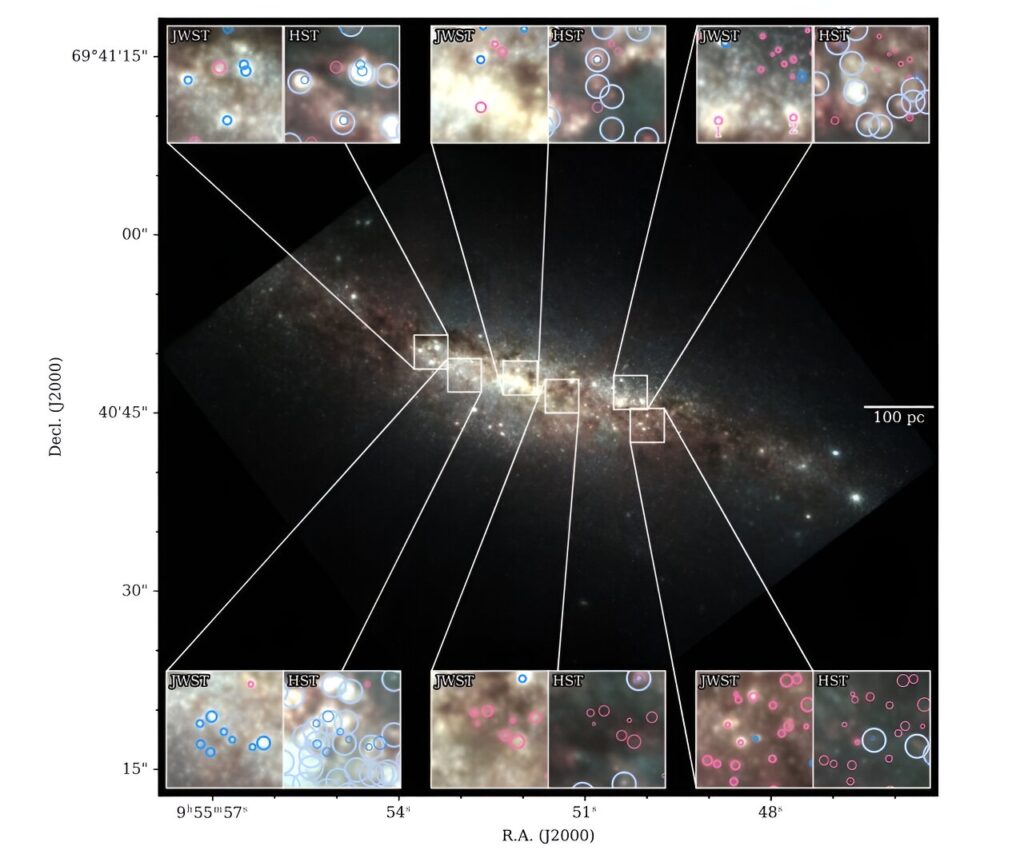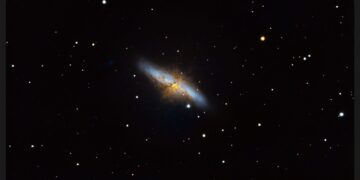JWST Uncovers Over 1,000 New Star Cluster Candidates in the Cigar Galaxy
Astronomers have made an exciting discovery that’s pushing the boundaries of our understanding of star formation. Using the advanced capabilities of the James Webb Space Telescope (JWST), a team of international researchers has identified over 1,000 new star cluster candidates in the Cigar Galaxy (Messier 82), located approximately 12 million light-years away.
Messier 82, commonly referred to as the Cigar Galaxy, is a small but highly active starburst galaxy. This type of galaxy is known for its rapid star formation, producing new stars at a rate ten times faster than our Milky Way. It’s a cosmic laboratory for studying how stars form, grow, and evolve, making it a prime target for the JWST. Past observations had identified around 600 star clusters in this galaxy, but the recent study, led by Rebecca C. Levy of the Steward Observatory in Arizona, used JWST’s Near-Infrared Camera (NIRCam) to peer deeper into the galaxy’s core and identify new clusters previously hidden by dust.

The team initially identified 2,472 star cluster candidates but, after further analysis, narrowed the list down to 1,357 robust candidates. These clusters vary significantly in size, with some containing up to one million solar masses. This is particularly important because star clusters are like cosmic cradles, where stars are born and evolve. By studying them, astronomers can better understand the processes that govern star formation, especially in galaxies experiencing starbursts.
What makes this discovery so groundbreaking is the youth and dust-obscured nature of these clusters. According to the research team, the clusters are heavily reddened due to dust extinction, indicating that they are relatively young and still embedded in the gas and dust from which they formed. This makes them especially valuable for studying early star formation in environments that mimic conditions in the early universe.
The ability of JWST to see through this dense dust and capture the light from these clusters is a testament to the telescope’s advanced technology. Its NIRCam allows astronomers to observe in the near-infrared spectrum, which is crucial for detecting light that has traveled through dust clouds. With this powerful tool, scientists can finally glimpse the hidden structures within galaxies like Messier 82.
Moreover, the significance of these findings lies in the potential to advance our understanding of starburst galaxies and the conditions that lead to prolific star formation. Messier 82’s starburst activity provides a unique insight into how star formation can be triggered and sustained on such a large scale. This has broader implications for studying similar galaxies in the early universe when conditions were more conducive to rapid star formation.
Looking ahead, the researchers plan to conduct more detailed studies of these star clusters, including spectroscopic observations that will allow for precise measurements of their mass and age. These follow-up studies could reveal even more about the conditions in starburst galaxies like Messier 82, helping us understand not just this galaxy, but the broader mechanics of star formation across the universe.
This discovery offers astronomers a rare opportunity to study young star clusters in detail, providing insights into how stars form and evolve in environments similar to the early universe.
Reference:
Tsai, W., Johnson, L. C., & Seth, A. C. (2023). Star Cluster Formation in M82: Insights from the James Webb Space Telescope. The Astrophysical Journal, 928(1), 67.



















